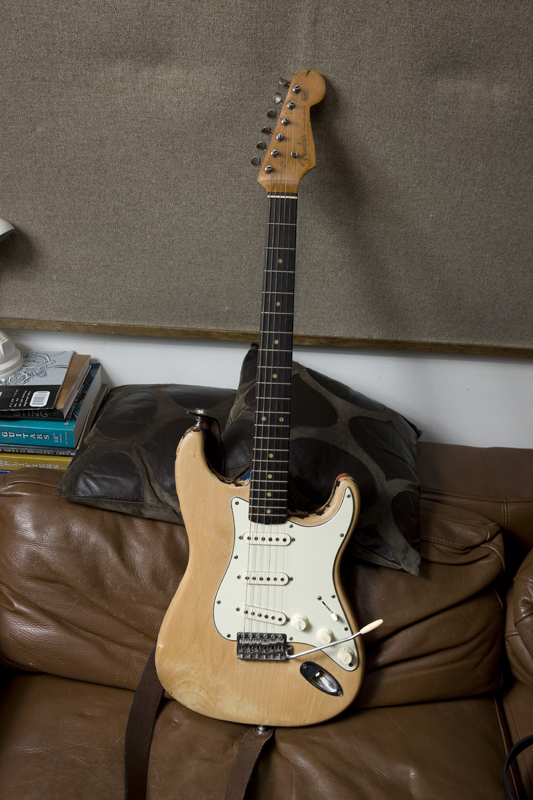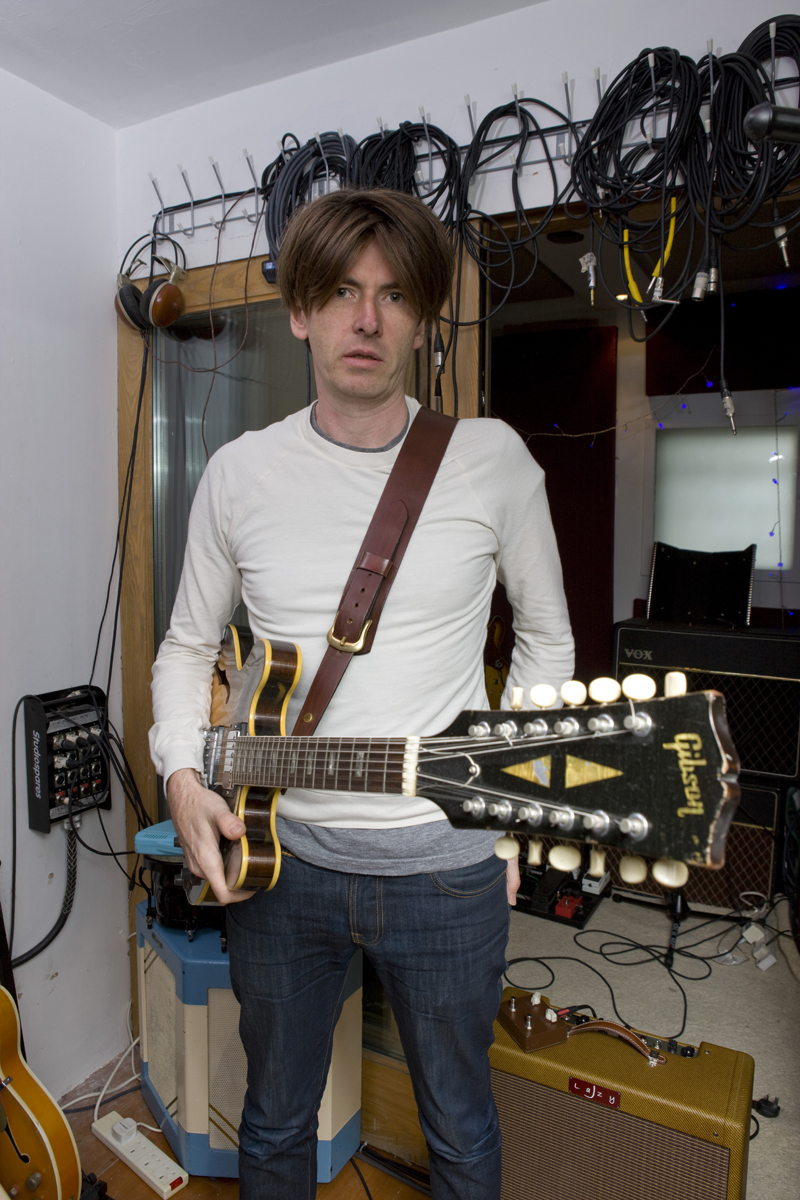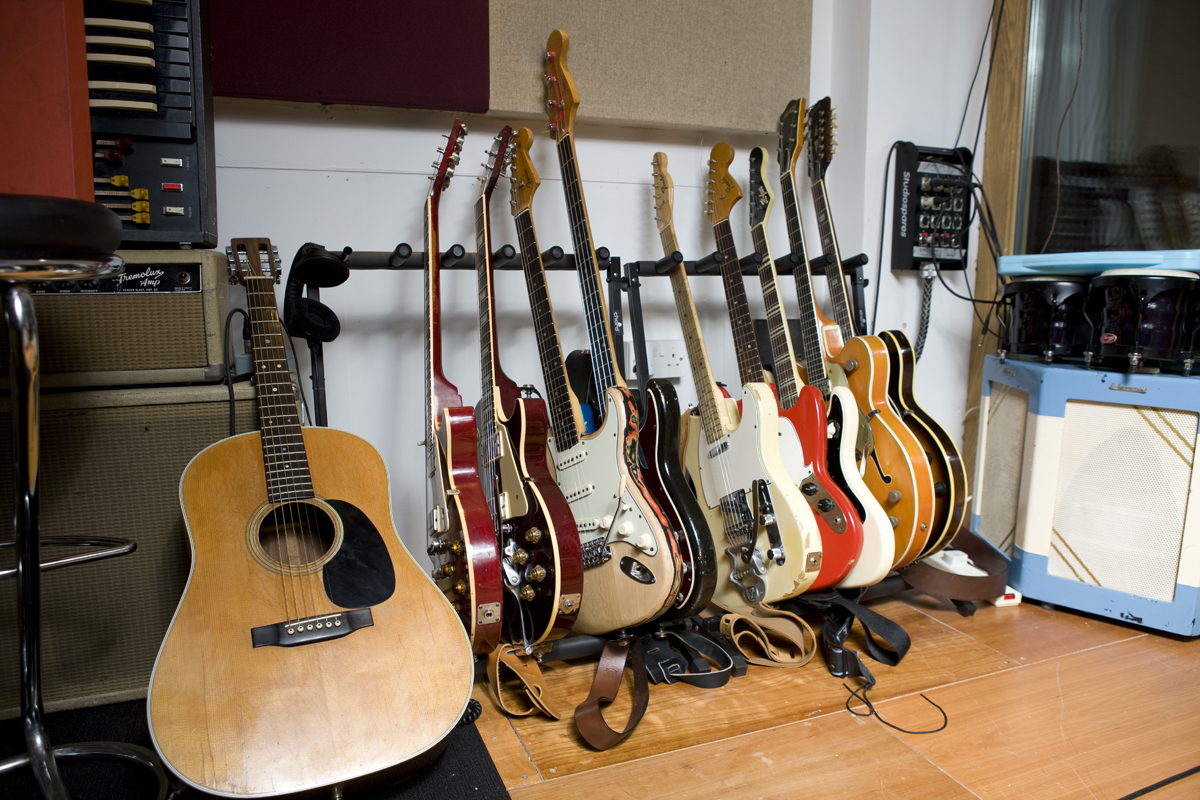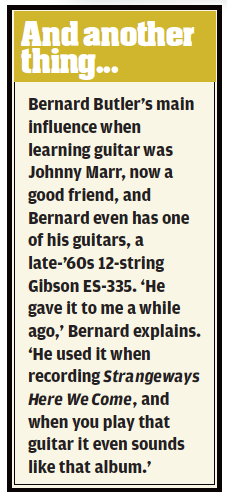Related Tags
Bernard Butler Interview – Trans Temporal
Bernard Butler invites G&B to his studio to talk of how a guitar inspired his new project Trans and of working with David McAlmont, Ben Watt, and folk legend Bert Jansch.

“To handle this guitar, you have to do your hair differently. A little ponytail, maybe… and you’ve got to wear a waistcoat!” jokes a Strat-toting Bernard Butler. It’s an incongruous sight, for Butler will be forever be associated with his iconic cherry red ES-355, a guitar choice that resulted in some of the most influential music of the ’90s, from the edgy, raw energy of Suede’s initial three-single assault on the charts that, more or less, launched a movement in indie rock that became known as Britpop, to the hugely popular, life-affirming McAlmont and Butler song Yes… a single which Butler still regards as his personal highlight.
We’re in Bernard’s Studio 355 on a cold Friday morning, an impressively decked out but still somehow cosy place that serves as his creative hub and base of operations. First things first; G&B must ask… how come, after all this time, a Strat?
“Well, I’d just never had one before,” Butler considers. “It was very much the ’80s guitar – when I was getting started there was the perception that if you played one, you were in Phil Collins’ band or something. But I was stuck on the sofa after breaking my leg playing football recently, I couldn’t move, and a friend of mine’s friend had died and left behind this vintage Strat…”
 The gorgeous custom strat in question
The gorgeous custom strat in question
“His missus wanted to get rid of it, and brought it round and put it in front of me. I spent around six weeks just playing it, falling in love with it and getting attached, and pretty soon I decided that I wanted to keep it.”
The Strat in question is a ’62, all original apart from many added coats of paint and a different scratchplate, and Bernard himself set to work on removing as much of the layers of refinish as possible. “I customised it myself, so I’m quite proud of it,” he says. “The interesting thing is that with a Strat, you find yourself thinking of yourself very differently – the way you stand and the way you approach playing the instrument all changes.”
“Technically speaking, I wouldn’t play the Strat with a tremolo.” Bernard continues “With the 355 I’ve always got a bit of tremolo going on, and a bit of reverb and a bit of drive, but with the Strat I’ll play it straight, plugged in and very dry. With the single coil pickups there’s less sustain, so you have to really work harder”
“I’ve found that the best way to play it is to really be quite aggressive with the rhythm playing. Playing the Strat like that led me on to wanting to form a band where I could play in this newly-developed style. That band eventually became my new band, Trans�… and it all stemmed from wanting to play my Strat.”
A closer look at the customisation Bernard has done to the strat, including sanding through various coats of paint (Click for Higher Res)
The new project came together very organically. “It was all improvisational. We’d have perhaps three days of just us in here, playing non-stop, and then we’d leave it a month and come back and do the same thing again. No-one would say anything – no pre-planning at all. Someone would just start playing and we’d all kick in and start adding to it, evolving it, layering it. We’d record the sessions and listen back. The jams would last around half an hour… or until we ran out of steam.”

Bernard with his iconic Gibson 355
“I’d press record the minute everyone was in the room so that every single note was down. I’d then go through the recordings and realise that most of it was utter rubbish! However, there’d be one or two little riffs, melodies or patterns that were really good, or two minutes at the start that were really cool. So I’d be isolating the hooks. Me and Jackie [co-member Jackie McKeown] would sit here and experiment, putting bits and pieces together.”
“We all agreed that the primary spirit of Trans is “if we’re enjoying it, then great”. We don’t really care if people dislike it. The whole reason we started was just to get in a room and play.”
Bernard’s studio is a treasure-trove of gear, but his ES-355 is still his main instrument of choice. “That guitar’s my taxi,’ he jokes. ‘If you’re a taxi driver you don’t sit there thinking how incredibly vintage your taxi is – you just get in every day, and it does the job. If I wanted to buy one of these now I couldn’t, because it costs too much. It’s a beautiful guitar that I know people lust after. I use that guitar every single day, and I have done since I bought it in 1993.”

As well as Trans, Bernard has been playing with ex-Everything But The Girl singer/guitarist Ben Watt. “With Ben, I’m just playing guitar. I’ve not been involved in the production or the writing, I’ve just been adding bits here and there. It came at a really nice time when I’d done a lot of writing and production work and was starting to feel a little bit jaded, and when he just asked me to play guitar, I thought “brilliant!”
 “He’ll sometimes say to me, ‘You see that chord there? Don’t play that’. I found that directness so refreshing! I’ve worked with people over the years who would say ‘but that’s my chord, I always play that chord’ and get really touchy! I’d rather eliminate these problems during the making of the music. You’re a better person and musician for it.”
“He’ll sometimes say to me, ‘You see that chord there? Don’t play that’. I found that directness so refreshing! I’ve worked with people over the years who would say ‘but that’s my chord, I always play that chord’ and get really touchy! I’d rather eliminate these problems during the making of the music. You’re a better person and musician for it.”
‘Ben will use oddly-tuned acoustics and electrics along with a Wurlitzer, whereas I’m just on a standard-tuned electric, maybe dropping the low E to D, and using capos quite lot. My thing with Ben’s material is to fingerpick, mainly on the bass pickup. I just developed a sound that would complement his stuff. There’s hooks peppered all through the songs, but around them I’m really free to do what I want. I’m trying to emphasise images in the words with little slides, bends and dynamics. The darker moods naturally fall to the deep end of the neck, and the more poignant moments to the other end.’
Butler’s fingerpicking is very much informed by the live and recording work he did with the late, great Bert Jansch. “I befriended Bert quite casually but then we ended up playing a great deal together and doing lots of shows. He was amazing… incredibly technical but also in his own little world when he played.”
“It was hard to pin him down with timing and specific things. To play alongside him was quite tricky. Learning his parts was a bit of a waste of time. I learned quite early just to improvise and feel my way around, anticipating where he was going to go next. I did the same thing I’m doing now with Ben – fingerpicking on the bass pickup for the bassy, bluesy sound, and I kept that approach going when I work with different people”
“I’ve discovered little techniques which act as quite dramatic mood shifts, like sticking on the bass pickup for the more rounded phrases, then flicking down to the treble pickup to bring out sharp jagged notes, and particularly solos. Flicking the pickup selector can be quite dramatic, and you have to aim to switch on the downbeat to make the whole movement musical as well as theatrical. I’ll have my little finger curled around my Bigsby most of the time, and the same finger is ready to flick the selector down. I use some subtle roll-offs on the volume knob to force me to pull the notes harder, making the notes more choked and aggressive. That also seems to make the amp work harder.”
 “It’s entirely character technique over virtuosity for me. I look at a simple three-chord movement or arpeggio anyone can play and try and see how I can make the simplest notes you’ve heard before say something new, bringing out the emotional content. A lot of Ben’s songs are very personal, so I like to bring out that sadness and – in a way – something quite musically dysfunctional. Guitars are mechanical… it’s so easy to do this stuff, to make your chords more interesting. A straight A major can be transformed by string bends within the chord, or a little Bigsby, or using fingernails to tremolo the last note.”
“It’s entirely character technique over virtuosity for me. I look at a simple three-chord movement or arpeggio anyone can play and try and see how I can make the simplest notes you’ve heard before say something new, bringing out the emotional content. A lot of Ben’s songs are very personal, so I like to bring out that sadness and – in a way – something quite musically dysfunctional. Guitars are mechanical… it’s so easy to do this stuff, to make your chords more interesting. A straight A major can be transformed by string bends within the chord, or a little Bigsby, or using fingernails to tremolo the last note.”

Bernard’s impressive axe collection, what every studio needs!
 We ask Bernard about the start of his career in Suede and being regarded as the UK’s premier guitar hero of the era “Well I just wanted to be the best, from my point of view I just thought to myself ‘I’ve just got to be brilliant” Bernard says “I wanted Suede to be absolutely amazing. I just felt that nothing is deserved and we had to really prove ourselves. I worked so hard and got very angry when people were complacent about us” Dog Man Star, the remarkable second album from Suede, coincided with the guitarist’s departure from the band. Now the dust has settled, how does he feel looking back at the music? “I’m really proud of Dog Man Star – I was proud when I was writing it, I was proud being part of the band,” Bernard says. “Brett [Anderson] and I were completely united about what we wanted to do. Loads of people have made much better records than me, of course, but I don’t think I’ve encountered anyone with our level of ambition.”
We ask Bernard about the start of his career in Suede and being regarded as the UK’s premier guitar hero of the era “Well I just wanted to be the best, from my point of view I just thought to myself ‘I’ve just got to be brilliant” Bernard says “I wanted Suede to be absolutely amazing. I just felt that nothing is deserved and we had to really prove ourselves. I worked so hard and got very angry when people were complacent about us” Dog Man Star, the remarkable second album from Suede, coincided with the guitarist’s departure from the band. Now the dust has settled, how does he feel looking back at the music? “I’m really proud of Dog Man Star – I was proud when I was writing it, I was proud being part of the band,” Bernard says. “Brett [Anderson] and I were completely united about what we wanted to do. Loads of people have made much better records than me, of course, but I don’t think I’ve encountered anyone with our level of ambition.”
Bernard shows us some of the guitars and techniques he used in these early days of Suede, including his original Les Paul “This 1980 Les Paul Heritage was used on Suede’s first album, stuff like Animal Nitrate. It’s got a wonderful ebony fretboard which is so nice. I rented a 345 at the time and I also bought my first 355 but it got nicked – so I replaced it with that red one which I used from then on.” Bernard Butler may be regarded primarily as a guitar player extraordinaire but he’s also a multi-skilled man of music, producing and songwriting with a vast range of diverse artists including Duffy, the Libertines, the Cribs and Sophie Ellis Bextor. Right now, though, he’s focused on working with a range of new artists. “There’s got to be a reason for me to work with someone,” he says. “My primary mindset isn’t on recording them, it’s more to enhance, add or bring something new to the actual song or songs themselves.”
Bernard Butler may be regarded primarily as a guitar player extraordinaire but he’s also a multi-skilled man of music, producing and songwriting with a vast range of diverse artists including Duffy, the Libertines, the Cribs and Sophie Ellis Bextor. Right now, though, he’s focused on working with a range of new artists. “There’s got to be a reason for me to work with someone,” he says. “My primary mindset isn’t on recording them, it’s more to enhance, add or bring something new to the actual song or songs themselves.”
Butler recently reunited with David McAlmont for a string of McAlmont and Butler charity performances at the Union Chapel. ‘I hate the word reunion,’ he points out. ‘David and I never split up, we’ve played gigs in the interim period. What happened with the recent shows was that I’d just run the marathon and was trying to raise some money, so we decided to play the Union Chapel thinking that we’d sell 300 tickets and it’d be a good laugh – and it actually sold a thousand tickets in five minutes!” “The shows were great fun. It was that rare thing where you go on stage and play a song and you just feel like you’re not really playing. We played Yes and I looked out at the audience and thought, this is the easiest thing I’ve ever done… why the hell don’t I just stick to this? It was a really beautiful moment. It’s a very rare thing to write a song and see people genuinely loving it. That feeling of making someone’s three minutes better is unbeatable. That’s what music means to me.”
“The shows were great fun. It was that rare thing where you go on stage and play a song and you just feel like you’re not really playing. We played Yes and I looked out at the audience and thought, this is the easiest thing I’ve ever done… why the hell don’t I just stick to this? It was a really beautiful moment. It’s a very rare thing to write a song and see people genuinely loving it. That feeling of making someone’s three minutes better is unbeatable. That’s what music means to me.”
So after McAlmont and Butler’s remarkable return, can we expect a third album? “We actually did record a load of material for the third album after finishing our second record, Bring It Back, which were never released. There’s loads of great songs there, and they will come out as we get round to it. If the world can’t wait, it can’t be very good in the first place!”
You can read more of Bernard discussing his approach to production and his history over at MusicTech.net (soon!)
BernardButler.com 
